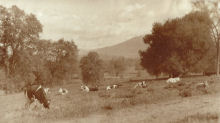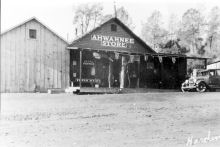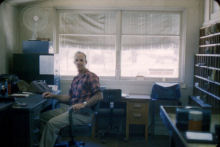History of the Ahwahnee Hills Regional Park
The land was once used as a home by Native Americans. (Ahwahnee is an Indian word meaning “deep grassy valley.”) In 1851, a force of 74 Anglo miners under the command of Captain James Burney, Sheriff of Mariposa County, fought a battle with the Miwok Indians on or near the park. Lt. Skeane S. Skeenes received a mortal wound in the battle and was buried in what is now the park. In 1970 his body was moved to Oakhill Cemetery in Oakhurst.
The first owner of the property was Franklin Dennis, who homesteaded 160 acres on the future park site in 1882. The property then passed to Martin H. and Bessie Cassell, who by 1891 owned 320 acres.
Ahwahnee Tavern Stage Stop (1893 - 1913)
Sometime about April 1892, the property was purchased by Albert Henry Washburn (1836–1902), owner of the stage company that operated between Raymond and Wawona. In August 1892, Washburn sold the property to William Martin Sell, Sr. (1854-1932). Sell soon built the two-story Ahwahnee Tavern to serve as a stage and luncheon stop on the Raymond to Wawona Road. Sell had earlier been the first person to send a telegraph signal out of Yosemite Valley. Washburn built stables and other buildings and operated the Ahwahnee Tavern in partnership with Sell.
In 1903, President Theodore Roosevelt had lunch at the Ahwahnee Tavern on his way to meet John Muir and visit Yosemite Valley. Other famous visitors included Susan B. Anthony, Andrew Carnegie, John D. Rockefeller, and Crown Prince Albert of Belguim.
In 1906 William Sell moved to El Portal to build the El Portal Hotel. In his absence, Edwin T. Huffman leased and ran the tavern. Horse-drawn stages were gradually replaced by automobile stages, and in 1913 Huffman moved his operations to the Miami Lodge, which he had built in a location better situated for automobile traffic.
Tri-County Tuberculosis Sanatorium (1918 - 1969)
In 1918 the Sells sold the Ahwahnee Tavern and ranch to Madera, Merced, and Stanislaus Counties to create the Tri-County Tuberculosis Sanatorium. The counties also purchased an adjacent parcel to increase the size to 480 acres. The sanatorium built dozens of structures over the years, including a hospital complex, quarters for doctors and nurses, a children's home, and a school. Julia Morgan, noted architect of Hearst Castle, designed some of the buildings. The original tavern building served as a kitchen and dining area until it burned down in 1937.
The sanatorium started with 16 patients and eventually grew to care for more than 100. Besides taking care of patients, sanatorium staff kept farm animals and grew fruit and vegetables on the property. The patient load declined as new techniques and medicines were found to treat tuberculosis, and the sanatorium closed in 1969.
Ahwahnee Hills School for Boys (1969 - 1985)
In 1969, a private non-profit corporation established a school on the site, using many of the existing buildings, for boys with behavioral problems. The students learned to care for the school's animals and perform other vocational tasks. The population of boys eventually reached 59, with about that many staff. The school closed in 1985. The property ended up in the hands of Madera County and a caretaker lived on the property until the early 1990’s, at which time local residents began to push for establishing a park on the site. That was the beginning of the Friends of Ahwahnee Hills Regional Park.
Development of the Park
In 2005, a study was done by consultants to meet the requirements for the California Environmental Quality Act (CEQA). This provided wetlands guidance for park development. Corps of Engineers approval was also required. Additional studies were done in 2006, 2007, and 2008.
In 2006, Madera County funds provided asbestos cleanup.
From 2006 to 2011, a Proposition 40 grant of $204,000 provided the restroom at the lake, restoration of the old barn, environmental studies, installation of a new well, pump, storage, and water distribution system, plus electrical circuitry for the proposed ball fields. Sunrise Rotary provided funds for the initial work on the ball fields area.
In 2007, the Sierra Nevada Cascades Grant of $417,000 was used for Interpretive Center restoration, picnic tables, barbecues, the main restroom, major electrical work and a potable water system.
A Proposition 12 grant of $150,000 in 2008 provided funds for the installation of picnic tables and barbecues, a potable well, the restroom at the ball fields, and environmental studies.
In 2009 and 2010, a Recreational Trails grant of $410,000 was used to build the walking and equestrian trails, complete with bridges, and to pay for another study for the National Environmental Protection Agency. Also in 2010, the State Integrated Waste Management Board cleaned up the dump sites, tore down most of the old sanatorium buildings, removed metal waste, and ground up the concrete foundations of the old buildings.
Finally, in 2011 the park received a grant of $470,000 from Proposition 84 (Nature Education Facility Program) for an Oak Acorn Center. This will allow reworking of the old bicycle shop into a natural history building specializing in telling the story of the Central Valley’s oaks and oak woodland habitat.
Historical Photos
 |
 |
 |
 |
 |
 |
 |
 |
 |
 |
 |
 |
 |
 |
 |
 |
 |
 |
 |
 |
 |
 |
 |
 |
 |
 |
Ahwahnee Region Historical Photos
 |
 |
 |
 |
Unless otherwise noted, photos are the property of their respective copyright owners and used by permission, and may not be reused without
explicit permission from their owners.
